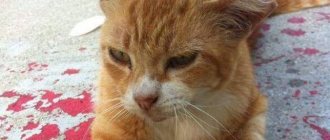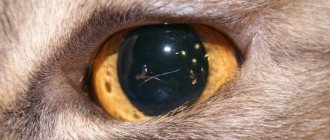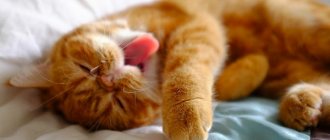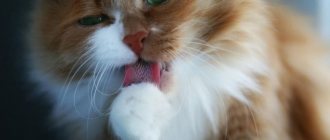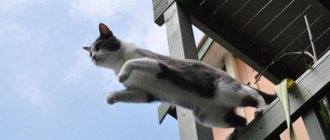16445Administration
If a cat poops with blood, in most cases this is really a reason to urgently contact a veterinarian. This phenomenon usually indicates serious problems in the pet’s health.
Extravasates (blood clots) in a cat’s feces should be absent during normal functioning of the digestive tract, so the owners should not ignore their appearance. However, it happens that if a cat poops with blood, then this is not at all a symptom of a serious illness, but only when such a case is one-time, and not repeated from time to time.
© shutterstock
Why does a cat poop blood?
The appearance of blood in the stool is a symptom of the following diseases or pathological conditions:
- Infectious diseases.
- Helminthic or protozoal parasites.
- Poisoning with hemolytic poisons.
- Side effects of medications.
- Allergic reaction to food components.
- Mechanical damage due to constipation or inedible objects getting inside.
- Intestinal obstruction or obstruction.
- Diseases of the hematopoietic organs.
- Stomach or duodenum ulcer.
- Inflammatory bowel diseases.
- Pancreatitis, hepatitis, other chronic pathologies.
- Lack of water when feeding dry pellets.
Diagnostics
The key to successful treatment is a thorough diagnosis. The veterinarian conducts a clinical examination, collects anamnesis, and asks questions to the pet owner. If necessary, additional diagnostic methods are prescribed:
- blood analysis,
- stool examination to determine the presence of helminths or protozoa,
- Analysis of urine,
- colonoscopy.
Additionally, an ultrasound or x-ray examination of the abdominal cavity is prescribed to exclude or confirm the possibility of damage to internal organs.
Description of blood in stool, depending on the cause
First of all, you should make sure that the cause of the change in stool color is blood. Adherents of natural nutrition are frightened by the red-brown color of feces when including large amounts of beets and other dark-colored vegetables in the diet. If foods rich in pigments are excluded from the diet, the cause of the change in stool color can be determined.
There is a distinction between latent and obvious blood. If the outlet is smeared and tarry, it means bleeding occurs in the initial parts of the gastrointestinal canal and has been exposed to digestive enzymes.
Brown-black feces, called melena, are completely washed away with water without sediment. However, it should be noted that feces acquire a black color after feeding with activated carbon.
Obvious blood or hematochezia is noticed when examining the fecal matter. In this case, the source of hemorrhage is located behind the duodenum.
Be sure to read:
A cat often burps: causes, symptoms, what to do when vomiting after eating, prevention, what not to do
Single drops indicate a scratch or crack in the anal sphincter. The feces acquire a burgundy or red-brown color when the source of bleeding is located in the initial segment of the large intestine.
Cherry or crimson coloring indicates hemorrhage in the rectum or posterior colon. Red stools with diarrhea cannot indicate the place where the bleeding occurred due to the high speed of passage of fecal matter.
What to do before visiting a doctor?
If the animal's condition and behavior are satisfactory, and there are no accompanying symptoms or they do not cause concern (for example, one-time diarrhea or constipation against the background of general health), the cat owner can take some actions before going to the veterinary hospital.
These measures include:
- Treating the animal against intestinal parasites (deworming). To do this, you need to purchase a specialized drug with an extended spectrum of action from a pet store and give it to the animal according to the instructions. If dead parasites appear in the cat’s feces within 24 hours, deworming is carried out again after ten days, monitoring the pet’s condition.
- Normalization of diet. The cat needs to be switched to a balanced diet; the easiest way to do this is to opt for ready-made dry food of the “holistic” class. They will provide the animal with all the necessary substances and elements; in addition, such food is hypoallergenic and safe.
- For long-haired cats – cleansing the intestines of hairballs. To help your pet get rid of them, it is enough to purchase a special paste. You can consult with the seller at the pet store. The paste is given to the animal according to the instructions, usually on an empty stomach (a couple of hours before feeding) twice a week.
How to protect your cat from hairballs?
If these recommendations do not work, and blood continues to appear in the cat’s litter box during bowel movements, you should not delay your visit to the clinic. The veterinarian, after listening to the complaints, will carry out the necessary diagnostic procedures to identify the cause of the alarming symptom.
Actions before visiting a veterinary clinic
An emergency situation in which the cat must be taken to the clinic immediately occurs when there is significant blood loss, characterized by the following symptoms:
- profuse hematochezia or melena;
- vomiting black coffee-colored contents;
- depression, shortness of breath, loss of consciousness.
In such a situation, the cat must be taken to the clinic in your arms, head down, so that oxygen starvation of the brain does not develop. Frozen meat from the refrigerator is placed on the stomach.
If one or several drops of scarlet blood appear on the surface of formed feces, you can treat the anus with antiseptic ointment. If constipation is suspected, Vaseline oil is used. Vegetable oils help eliminate stool retention, but have side effects on the liver.
When the bleeding is not profuse, the owner can try to solve the problem on his own using the following techniques:
- Deworming . Nematodes injure the mucous membrane, destroy capillaries, and droplets of blood are released. If the animal has not been dewormed for more than three months, an anthelmintic should be used.
- Change of diet. You need to stop treating your pet with food from the table, as well as treats purchased in the store. Your pet may have an allergic response to food components. If you replace ready-made economy-class food with premium ones, the problem may disappear. Dry granules enter the stomach, and if the drinking bowl is dry, they absorb moisture from the mucous membrane. In this case, trauma occurs with the destruction of small vessels.
- Cleansing the intestines from trichobezoars. Pets, especially long-haired ones, swallow hairs when licking. Hairballs form and combine with the intestinal contents. Soft stones form, blocking the intestines partially or completely. Defecation becomes difficult. The cat strains, and small blood vessels burst from overexertion. Blood flows out. Pets walking outside eat grass and vomit, causing hairballs to come out. Owners of cats who spend their entire lives in an apartment need to switch to super premium food, which contains components that prevent the formation of bezoars, or use Malt paste, which removes hairballs in feces.
- Help with dehydration. To prevent the animal from dying before the veterinarian appears, subcutaneous administration of saline or Ringer-Locke solution in unlimited quantities is allowed. Bubbles appear that quickly resolve.
Be sure to read:
The cat cannot pee: causes, symptoms, what to do, first aid, treatment at home
Constipation and its treatment in cats
Many times in medical practice there are situations when it turns out that a cat goes “out of need” with blood (sometimes with mucus) due to banal constipation. Hardened feces cause a lot of inconvenience and pain to your pet during defecation. Such stool, having difficulty moving along the intestinal walls, contributes to constant injury to the anus, creating microcracks, tears and ulcerations.
To treat constipation, the veterinarian usually prescribes laxatives and special medications that help the animal get rid of stuck hairballs during bowel movements. Dehydration caused by hot weather and lack of drinking water could also cause the onset and development of constipation in a cat. After implementing the necessary therapeutic measures, the stool used by the animal should return to normal, and the blood present in it should disappear.
When to seek help from a veterinarian
If drops of blood appear in the stool, pay attention to the following additional symptoms:
- the cat is depressed;
- loss of appetite;
- mucus or undigested pieces of food are found in feces;
- when defecating, the cat arches its back and meows pitifully;
- vomiting occurs periodically;
- bleeding occurred in a cat suffering from a chronic disease;
- Melena was discovered during the use of hormonal or non-steroidal anti-inflammatory drugs.
If the above additional signs are combined with the slightest hemorrhage, a visit to the veterinarian is necessary.
Additional symptoms
Pathologies manifested by blood in the stool are often infectious in nature. Therefore, there are also other signs of the disease:
- a sharp decrease in the pet’s body weight;
- vomiting/diarrhea;
- thirst;
- weakness, apathetic behavior;
- frequent urge to urinate (urine may be bloody);
- pain syndrome.
If one or more symptoms occur, you should immediately take your cat to a veterinary clinic. After the examination, treatment will be selected for the animal.
Common additional symptoms of pathology
Preventing your cat from bleeding during bowel movements
To prevent blood from appearing in your cat’s stool, the following requirements must be met:
- provide adequate feeding with benign ready-made food or natural products;
- do not treat your pet with human food;
- carry out regular quarterly deworming;
- vaccinate pets according to the vaccination plan;
- provide free access to water;
- do not let your pets go outside hungry so that they do not eat poisoned mice;
- do not self-medicate, resort to the services of professionals.
How to treat
The treatment prescribed by the doctor will depend on the problem identified during diagnosis.:
- for a viral disease - antiviral drugs;
- for bacterial infections – antibiotic therapy;
- if the cause is hairballs, special foods or pastes will remove them from the digestive organs;
- wall ruptures (perforation), poisoning with bleeding or poor clotting are treated with vitamin K and hemostatic drugs;
- against protozoa and parasites - special remedies for them;
- if there are problems with the liver or pancreas - enzymes to restore digestion, hepatoprotectors to protect the liver;
- for dysbacteriosis, enterocolitis, colitis, allergies and constipation - probiotic preparations and a special light diet;
- if a foreign body has entered the intestines, polyps have grown, or a malignant tumor has formed, recovery can only be achieved through surgery.
In other words, each individual case receives individual treatment.
© shutterstock
Principles of therapy
If the animal’s life is in danger or surgery is necessary, the cat is placed in a hospital. In other cases, the owner is given recommendations regarding treating the pet at home. The treatment plan is drawn up depending on the diagnosis:
- If parasites are detected, Dirofen, Prazitel, Drontal, Mibelmax are prescribed.
- Pancreatin and Creon help eliminate malfunctions of the pancreas and liver.
- If constipation, dysbiosis or allergies to certain foods are diagnosed, the animal needs a special diet and probiotics - Enterol, Bifitrilak, Zoonorma. To eliminate allergy symptoms, Tavegil and Suprastin are prescribed.
- Infectious diseases are treated with Aminovit, Maxidin.
- In case of intoxication, blood clotting disorder or intestinal injury, it is necessary to give the animal vitamin K, as well as Vikasol or Dicion.
- If there are hairballs in the stool, you should feed your pet with special food and dietary supplements that promote regurgitation of swallowed hairs.
- Tumors, neoplasms and foreign objects are removed surgically.
Preventive actions
Of course, it is difficult to prevent all the reasons why cats go to the tray with blood, but you can reduce the risk of pathology by following certain rules:
- Timely vaccination of kittens.
- Regular antiparasitic treatment of animals.
- Maintaining water regime.
- A balanced, healthy diet helps prevent constipation. Choose food wisely.
- Attentive attitude towards the animal, which consists in preventing: self-walking; contact with poisons, chemicals and toxic substances; contact with street and sick animals.
- Increasing the animal's physical activity to improve metabolism.



